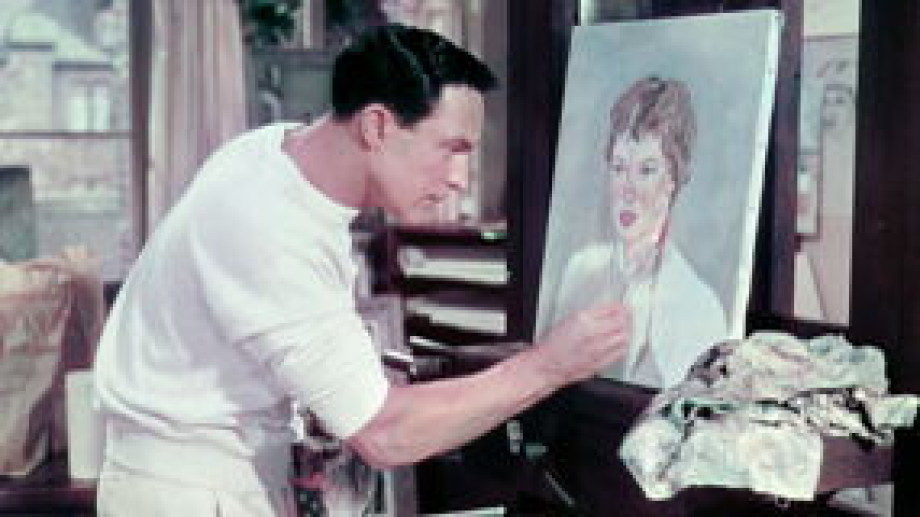
Leslie Caron and Gene Kelly in Vincent Minnelli's An American in Paris
The nine years between Gene Kelly’s screen debut in For Me and My Gal and his finest hour (or at least his finest seventeen minutes) in An American in Paris seem, in many respects, a great, wide chasm. Busby Berkeley’s uncharacteristically modest, black-and-white wartime rouser is, stylistically, worlds apart from Vincente Minnelli’s operatic fever dream of a picture, painted in colorful, impossibly vivid strokes. In the earlier film, Kelly’s opportunistic hero wins, by virtue of a final, desperate act of heroism, a moral victory far out-of-proportion to the modesty of its onscreen expression. Nine years later, the expression would be the thing itself. An American in Paris’ stunning final dance sequence renders irrelevant questions of character, motivation, and even ethics. It’s easier to consider Kelly’s onscreen presence in the same way we’d describe the film itself: in terms of rhythm and color and light. He is, quite literally, bigger than life.
That said, For Me and My Gal and An American in Paris have at least one point of common ground. Both Berkley and Minnelli pit the godlike Kelly against a mere mortal—though an impossibly kind and generous one—for the affections of their leading ladies. In both cases, of course, Kelly wins. He shouldn’t.
Take the last scene of An American in Paris [major, major spoilers to follow]. Kelly, standing on the balcony of an elegant mansion, emerges from his seventeen-minute reverie (and from what is still, alongside the central ballet in The Red Shoes, the most astounding dance scene on film) to watch the woman of his dreams get into a limo with her golden-hearted French fiancé, the man who has looked after her since childhood. Kelly looks away, turns his back to us, and walks slowly back to the smoke-filled party within. Does Kelly’s failure to get the girl make him any less heroic? If anything, I’d argue, it elevates his story into the heights of tragedy, sculpts him into an icon for romantic hopefuls and broken hearts alike. There can be affirmation in failure, and dignity in loss.
How noble it would have been to cut to the closing credits then and there! Instead we see the limo return and Kelly’s love interest leap out. Her fiancé watches her run into Kelly’s arms, selfless to the end—he wants only for her to be happy. Only, now his loss doesn't earn any rhapsodizing, any seventeen-minute-long dance numbers. He recedes into the background and lets the lovers take their bow. Kelly wins, but his victory cost just as deserving a man his love and dignity alike.

George Murphy, Judy Garland and Gene Kelly in Busby Berkeley's For Me and My Gal
It’s those forgotten competitors who make For Me and My Gal and An American in Paris among the cruelest and most uncompromising of all the great Hollywood films. Kelly might be the hero to end all heroes, but his competitors earn our sympathy, if not our awe. They’re human, and their moral richness is all the more admirable for it. How, then, can it be anything but tragic when their loss is silenced – and even celebrated with one last, exultant swell of a score?
There’s a scene near the end of For Me and My Gal when Judy Garland runs into her former vaudeville partner Jimmy in Paris—they’re both there to perform for the American troops. They agree to get coffee, but she has to do one more number. “Can you wait ten minutes?” she asks. “You know me,” he stoically replies. “I’m a good waiter.” George Murphy’s performance is a masterclass in repression: whether he’s comforting Garland as she pines for Kelly or celebrating the pair’s impending marriage when they do finally get together, there’ll be a quiver in his voice or a single downcast stare, pointing unflinchingly towards a long-buried love.
Kelly and Garland do reunite at film’s end, of course, in time for one final refrain of the title number. The spotlight pans over the smiling faces of happy onlookers as the couple take the stage, and there among the well-wishers is Jimmy, smiling more than any. The spotlight moves away, leaving him in darkness, settling instead on the happy pair as they sing:
and sometime I’m going to build
a little home for two,
or three or four or more
in Loveland, for me and my gal…
If we could still see Jimmy through the spotlight’s glare, would we catch his smile slightly tremble?
An American in Paris screens Tuesday at 3:45pm and For Me and My Gal screens Wednesday at 3:15pm in our 23-film salute Invitation to the Dance: Gene Kelly @ 100. See both together and save with our Double Feature Package!



